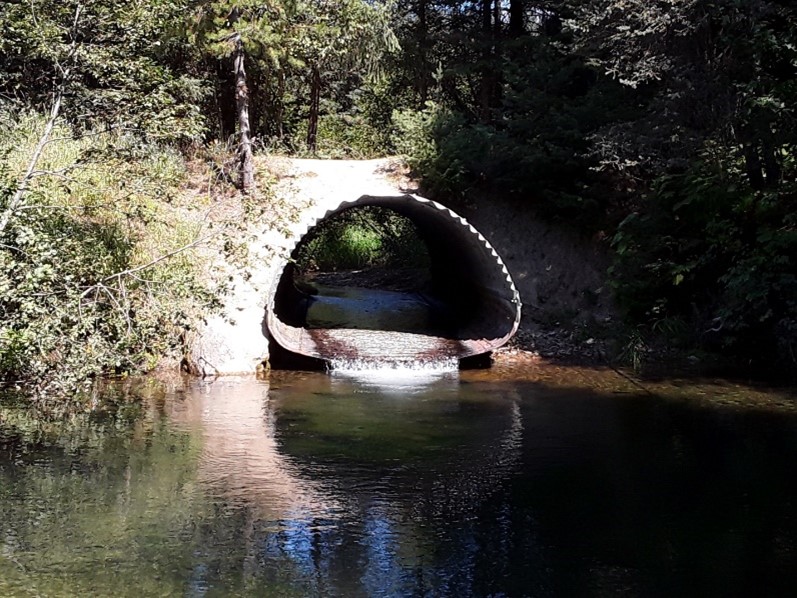Little North Fork Watershed Enhancement

Status: In Progress
Location:
The project area consists of the Iron Creek-Little North Fork Coeur d’Alene River watershed (HUC #170103010601), a tributary to the North Fork of the Coeur d’Alene River in Kootenai County, Idaho. The project area is about 14 miles east-northeast of Hayden, ID and 16 miles northeast of Coeur d’Alene, ID. Located in T51N, R1W, Section 6 and T52N, R1W, Sections 21, 28, 29, and 31.
Background:
The Little North Fork Watershed Enhancement Project will strengthen and expand stronghold habitat for westslope cutthroat trout by using a watershed-scale approach to protect and enhance uncontaminated streams and riparian areas that will benefit injured resources in the North Fork Coeur d’Alene River watershed (Tier 3 Priority in the Restoration Plan). Research done as a part of the Cold-Water Climate Shield project based on the Northwest Stream Temperature (NorWeST) database indicates the project area will serve as one of only four remaining drainages in the Coeur d’Alene River Basin with a high probability of supporting westslope cutthroat trout in 2040. Project activities would improve the hydrology and habitat function of Iron Creek and the upper Little North Fork so that they may serve as cold water refugia where westslope cutthroat trout persist and provide a source of fish to repopulate other areas downstream on the Little North Fork and the North Fork Coeur d’Alene River.
Progress:

This project contributes to and connects a long history of restoration work in the Little North Fork watershed. Beginning in 2012, the Forest Service began implementing the Moose Drool project and has invested nearly $3 million in the Little North Fork watershed decommissioning and storing 172 and 92 miles of road, respectively; removing 164 stream crossings and 5,200 feet of railway dike; restoring 3.3 miles of stream and floodplain; removing 11 fish passage barriers; and replacing another 10 with aquatic organism passage structures. This project will be completed in two phases and finish the 2012 watershed-scale enhancement project known as Moose Drool. The first phase will expand wetland habitat across 14 acres of historic floodplain along the Little North Fork at Hudlow Junction by removing and seeding over a mile of unauthorized off-highway vehicle trails, reactivating an historic secondary channel, placing over 1,000 pieces of large woody debris in the channels and on the surrounding floodplain, using minor excavation and the construction of beaver dam analogs to expand wetland habitat, and replanting areas with native riparian trees, shrubs, and emergent vegetation. The second phase will improve wetland and floodplain function along Iron Creek by relocating 0.4 mile of historic railway dike road (NFSR 1532) that diagonally bisects the valley, replacing an undersized stream crossing culvert on Iron Creek that disrupts the natural transport of streamflow, woody debris, and bedload with a bridge constructed using stream simulation design principles, placing large wood and beaver dam analogs within the stream channel and floodplain, and reconnecting 13 miles of high-quality aquatic habitat in the Iron Creek drainage by removing a fish passage barrier where NFSR 2346 crosses Iron Creek.
Plans:
We estimate that implementation of the entire project will take 3 to 4 years. Individual project activities would have both immediate and long-term benefits for westslope cutthroat trout and other aquatic and wildlife species. For instance, removal of the fish passage barrier on Iron Creek would immediately reconnect year-around aquatic organism passage to 13 miles of habitat for westslope cutthroat trout. Placing large woody debris or constructing beaver dam analogs in stream channels would immediately increase the amount and complexity of aquatic habitat and help reconnect the floodplain during higher flows. Over 22 acres of riparian habitat along 1 mile of stream would be directly enhanced through activities to restore native vegetation, add large wood or other structure (such as beaver dam analogs) to streams, and eliminate unauthorized motorized access to stream channels and floodplain habitat.
Benefits:
The project would improve water quality, wetland and aquatic habitat, riparian vegetation communities, and stream function and processes with benefits extending to three different classes of wetlands throughout multiple habitat types as described above. These improvements would benefit multiple injured resources including westslope cutthroat trout, the many other fish and aquatic species that share the same habitat, and lost human uses associated with westslope cutthroat trout and aquatic resources. Also, riparian restoration would benefit injured resources including songbirds, waterfowl, mammals, and amphibians that are at least partially dependent on riparian habitats.
Contact:
Wade Jerome
Restoration Biologist
Idaho Panhandle National Forests
173 Commerce Drive
Smelterville, ID. 83868
p: 208-783-2363 x2127
c: 208-512-5097
Terry.Jerome@usda.gov
Chris Robinson
Hydrologist
Idaho Panhandle National Forests, Coeur d'Alene River Ranger District
2502 E Sherman Ave
Coeur d’Alene, ID 83814
p: 208-769-3067
christopher.robinson2@usda.gov
Will Young
Fish Biologist
Idaho Panhandle National Forests, Coeur d'Alene River Ranger District
2502 E Sherman Ave
Coeur d’Alene, ID 83814
p: 208-769-3000
will.young@usda.gov
Sponsor:
Partners:
